Key takeaways:
- Game mechanics shape player experience and emotional engagement, as demonstrated through changes in jumping mechanics and puzzle interactions.
- Mechanics serve as a storytelling vehicle, impacting both gameplay and narrative depth through features like time manipulation and resource management.
- Collaboration and feedback are crucial in game design; insights gained from playtesting can lead to significant improvements and unexpected player interactions.
- Iteration is vital for refining game mechanics; small adjustments can greatly influence player experience and satisfaction.
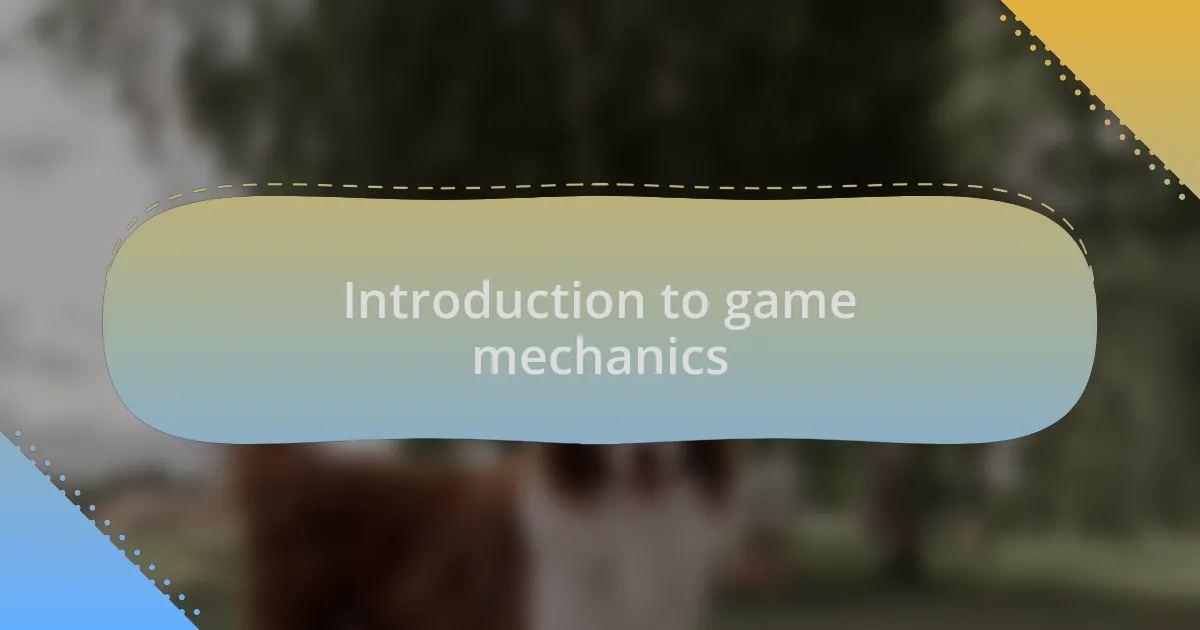
Introduction to game mechanics
When I first delved into game design, understanding game mechanics felt like unlocking a new level in my creativity. These mechanics are the rules and systems that dictate how players interact with the game world, shaping their experience and engagement. Have you ever considered how much a simple change in mechanics can alter the entire flow of a game?
One moment that stands out in my experience was while testing a platformer prototype. I tweaked the jumping mechanics, adjusting the physics to create a more responsive feel. Suddenly, the joy of soaring through the levels was palpable, both for me and the testers. This taught me that mechanics are not just technical; they play a fundamental role in evoking emotions and fostering connection between players and the game.
As I explored different genres, I realized the diversity of mechanics, from the straightforward to the intricate, each serving a unique purpose. Think about the difference between a racing game and a role-playing game—both have mechanics tailored to enhance their distinct experiences. Reflecting on these differences not only deepens my appreciation for the craft but also encourages me to experiment with new ideas in my own designs.
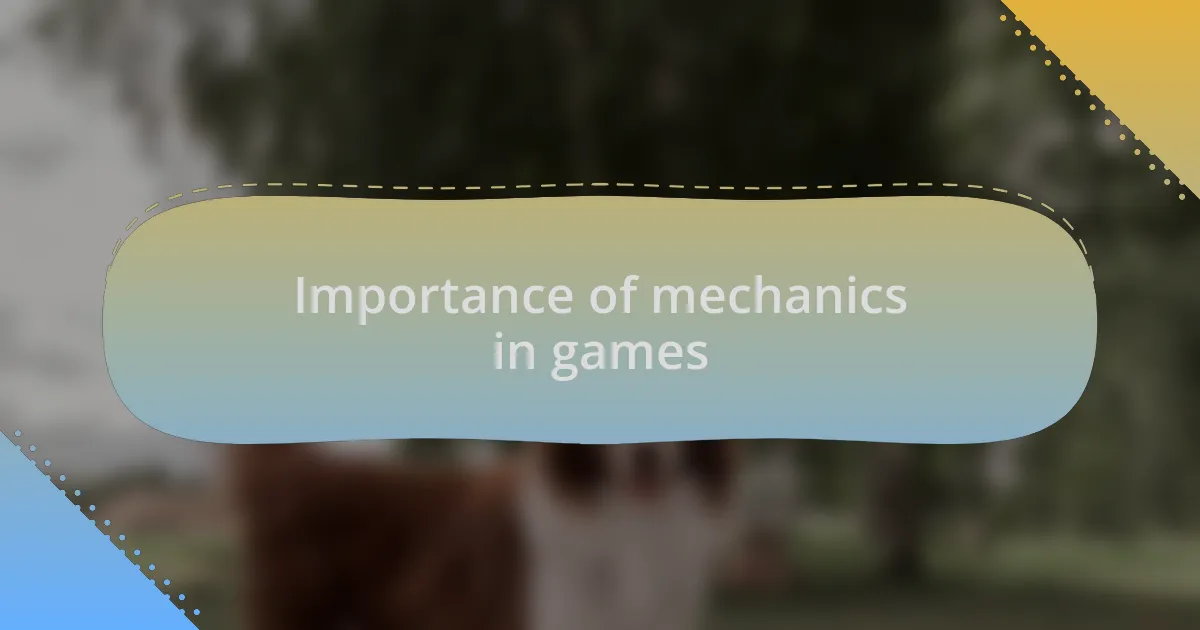
Importance of mechanics in games
When I think about the importance of mechanics in games, I reflect on my early days of design experimentation. I vividly remember a time when I was creating a puzzle game, and the challenge lay in how players interacted with the environment. After testing various mechanics, I discovered that introducing a simple drag-and-drop feature transformed player engagement. It made the puzzles feel more intuitive, and I came to appreciate that mechanics are often the bridge between a player’s understanding and their enjoyment.
Mechanics also serve as a storytelling vehicle, shaping not just gameplay but the narrative itself. I recall working on an adventure game where I implemented a character’s ability to manipulate time. This mechanic didn’t just add an intriguing layer to the puzzle-solving; it immersed players in a story about consequence and choice. Have you ever realized how some of the most memorable moments in games arise from mechanics that resonate deeply with themes? It’s those connections that make gameplay unforgettable.
Finally, mechanics influence the balance of challenge and reward, creating a satisfying loop of engagement. I once experimented with a combat system that relied on timing and precision. As soon as I refined the mechanics to reward skillful play, the excitement during battles was electric—players felt accomplished and motivated to push their limits. Mechanics play a crucial role in ensuring that a game is not only fun but also gives players a sense of progression and achievement, ultimately keeping them coming back for more.
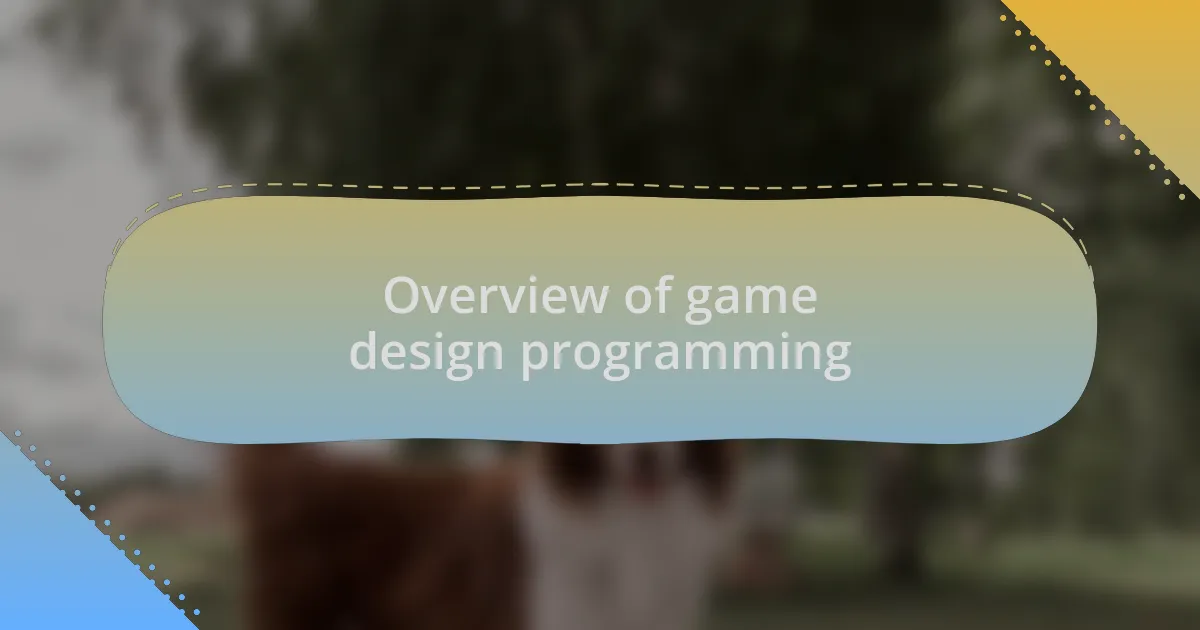
Overview of game design programming
Game design programming is an intricate blend of creativity and technical skill. During my first foray into programming a basic platformer, I was amazed at how a few lines of code could bring characters to life. Each jump, obstacle, and enemy I programmed felt like a miniature world unfolding before me. Have you ever experienced the thrill of seeing your code translate into gameplay? It’s a rush that fuels passion for game design.
At its core, programming in game design involves various languages and tools, each serving a unique function. I found that mastering C# for Unity was a game changer for me—pun intended! The ability to easily manipulate the game objects and implement complex mechanics made my ideas feel tangible. This also opened up the door to endless possibilities, whether it was creating AI behavior, developing levels, or refining user interfaces.
Moreover, the collaborative nature of game design programming often leads to unexpected innovations. I remember teaming up with a graphic designer and a sound engineer for a project. As we iterated on our ideas, their input transformed my initial concepts significantly. Have you ever worked with others and found their perspectives reshaping your vision? That synergy can elevate a game from a simple project to a remarkable experience, showcasing how programming is not just about code—it’s about collaboration and creativity.

Tools for game development
When diving into game development, the tools at our disposal are crucial. I vividly remember the first time I used Unreal Engine; the visual scripting feature, Blueprints, was like unlocking a whole new realm of creativity. Have you ever been so immersed in a tool that it sparked ideas you never thought possible? It’s all about finding the right software that resonates with your workflow.
Another game-changing moment for me was discovering version control systems like Git. Initially, I struggled with tracking changes in my codebase and often faced the dreaded “what did I break?” moment. Once I integrated Git into my process, not only did I feel more organized, but I also rediscovered the joy of experimentation without the fear of losing my work. How often do we get bogged down by the details? Finding a reliable tool can free you to innovate.
Lastly, graphics and art tools like Blender or Aseprite also hold immense value in game development. I recall my late-night sessions modeling simple characters in Blender, feeling a profound satisfaction as they came to life. The right graphics tool can turn a mere concept into something visually stunning, invigorating the entire game experience. What’s been your experience in creating art for your games? It’s fascinating how art can elevate gameplay, isn’t it?
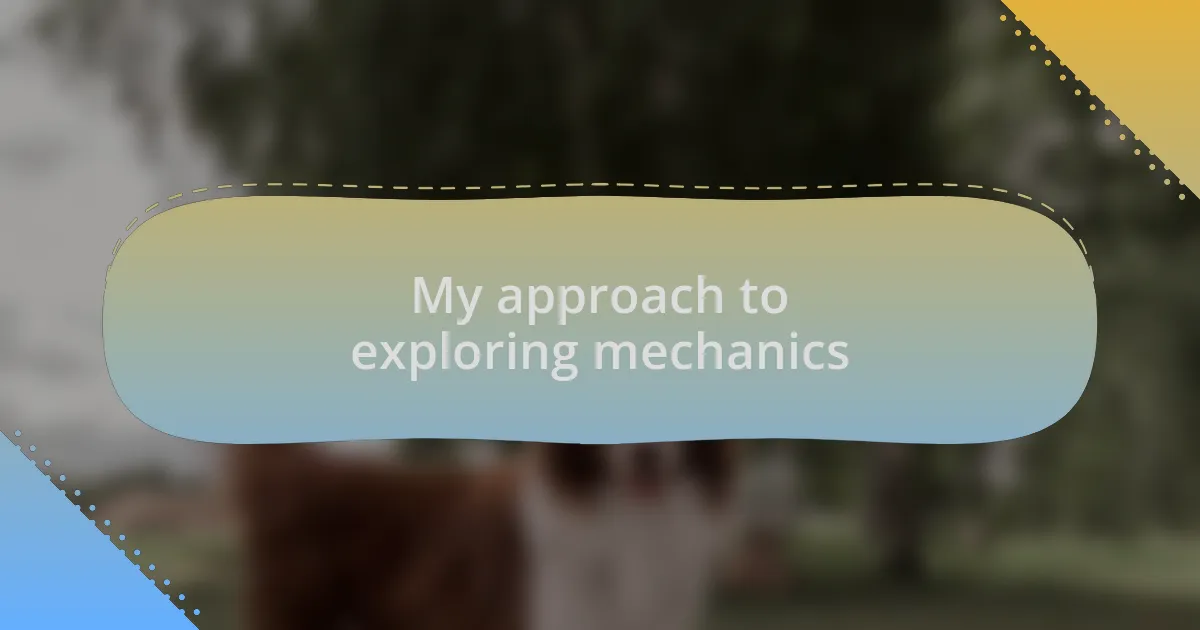
My approach to exploring mechanics
When I approach mechanics in game design, I start with a hands-on experimentation method. I remember one late evening when I was tweaking the jumping mechanics in a platformer I was developing. I altered the gravity settings and initially thought I had ruined the gameplay experience. But as I watched my character float unexpectedly, a whole new layer of fun emerged. Isn’t it interesting how simple adjustments can lead to unforeseen breakthroughs?
I also find that playtesting my own games provides invaluable insights. I often invite friends over for informal sessions, eagerly watching their reactions as they navigate through the mechanics I’ve crafted. Their unexpected solutions to challenges I thought were insurmountable remind me how diverse player experiences can be. How often do we assume players will follow our intended paths? Each playtest reveals unique interpretations that deepen my understanding of my designs.
Incorporating feedback is another vital aspect of my approach. After countless iterations, there are moments when I’ve had to set aside my pride. I’ll take a step back and truly listen to players’ suggestions, which sometimes stings when I think my mechanics are perfect. Yet, those insights often lead to the most rewarding enhancements. Have you ever realized that your vision may not align with the player’s experience? Embracing this perspective can truly transform your game.
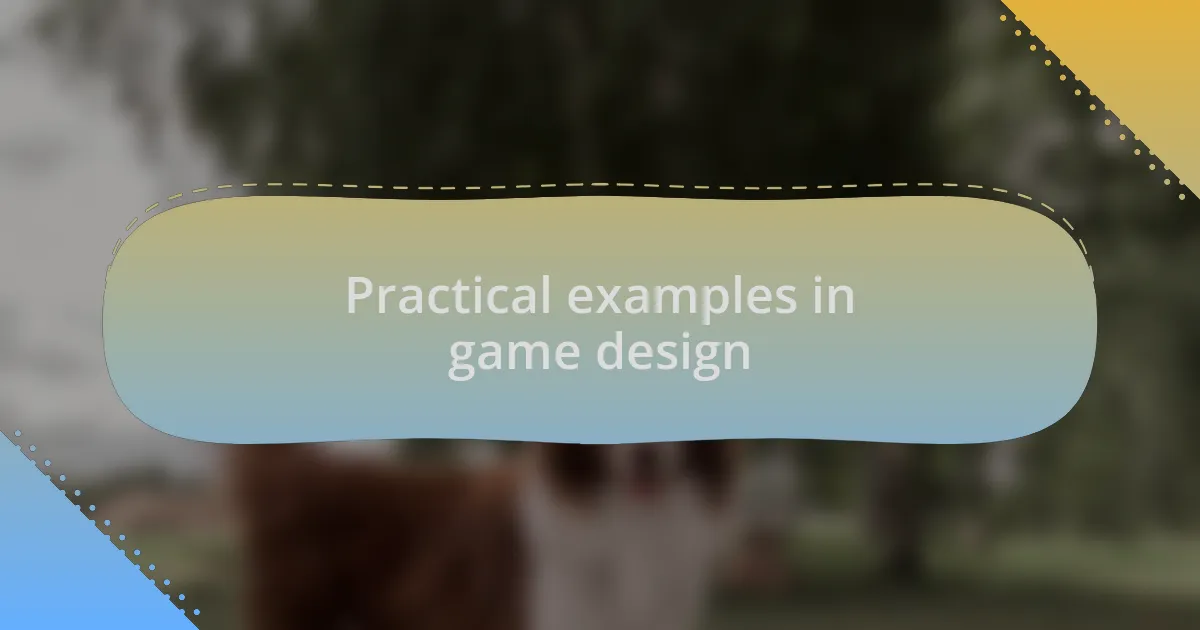
Practical examples in game design
Game design thrives on practical examples that illuminate the core mechanics I strive to master. For instance, in one project, I experimented with a stealth mechanic by introducing light and shadow dynamics. Watching players navigate a complex environment, trying to stay hidden, was fascinating. It truly highlighted how the mechanics I designed influenced their emotional engagement. Who knew that simply adjusting visibility could amplify tension in such a profound way?
Another memorable experience occurred when I integrated a resource-gathering mechanic into a survival game. I vividly recall the thrill of witnessing players meticulously plan their scavenging routes and the unexpected strategies they devised for managing limited supplies. I was amazed at how the pressure of scarcity led them to form alliances, which wasn’t something I had anticipated. Isn’t it compelling how a single mechanic can foster social interactions among players?
I’ve also dabbled in dynamic environments that respond to player actions, such as destructible terrain in a battle arena. I fondly think back to the intensity of playtesting when one of my friends strategically used explosives to create cover from incoming fire. His creativity reminded me that sometimes, the best moments arise when players discover ways to manipulate mechanics that I hadn’t fully considered. Isn’t that a testament to the collaborative nature of game design?
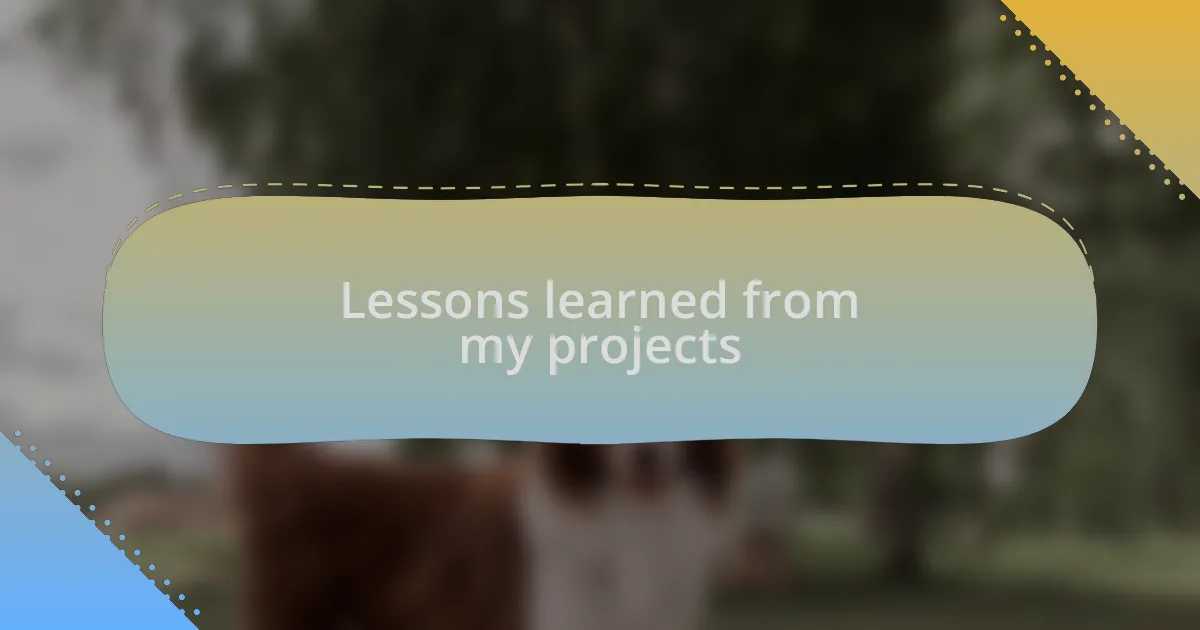
Lessons learned from my projects
Reflecting on the lessons from my projects, I often realize that playtesting is invaluable. I remember a particular instance where I implemented a physics-based puzzle in a platformer. It was my first time using such mechanics, and watching players struggle with the physics felt painfully familiar. Their frustration, however, opened my eyes to how critical it is to balance challenge and accessibility. Don’t you think finding that sweet spot can determine a game’s success?
Another significant takeaway came from developing an AI companion for an adventure game. Initially, my design focused solely on making the AI smart, but I quickly learned that players also connect emotionally with characters that exhibit quirks and flaws. During testing, I was surprised to see players form bonds with this imperfect AI, often expressing concern for its safety. Isn’t it fascinating how the human element can elevate mechanical designs to create deeper engagement?
Lastly, I cannot stress enough the importance of iteration. In a recent project, I revamped the combat system several times based on feedback. Each iteration taught me more about player expectations and dynamics. I vividly recall the moment a simple tweak to the cooldown times transformed the pace of the entire game. Isn’t it remarkable how small adjustments can lead to such significant shifts in player experience?